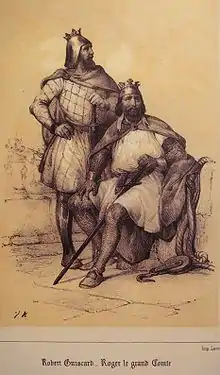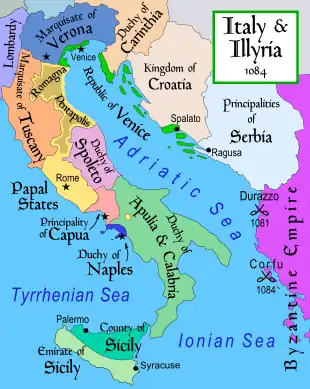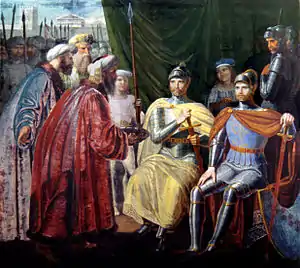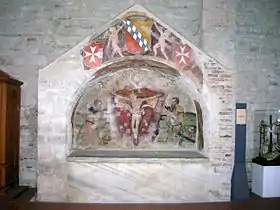| Robert Guiscard | |
|---|---|
 Coin of Robert Guiscard | |
| Count of Apulia and Calabria | |
| Reign | August(?) 1057 – 23 August 1059 |
| Predecessor | Humphrey of Hauteville |
| Duke of Apulia and Calabria | |
| Reign | 23 August 1059 – 17 July 1085 |
| Successor | Roger Borsa |
| Lord of Sicily | |
| Reign | 23 August 1059 – 1071 |
| Successor | Roger I |
| Prince of Benevento | |
| Reign | 1078 - 1081 |
| Predecessor | Landulf VI |
| Born | c. 1015 Hauteville-la-Guichard or somewhere else in Contentin, Normandy |
| Died | 17 July 1085 (aged 69–70) Cephalonia |
| Burial | |
| Spouses | Alberada of Buonalbergo, Sikelgaita |
| Issue | By Alberada (ill.): Bohemund I Emma By Sikelgaita: Elena (Olimpyas) Héria or Gersent, (wife of Hugh V) Matilda Roger Borsa Guy Sybilla, (wife of Ebles II) Mabile Robert Scalio |
| Noble family | Hauteville |
| Father | Tancred of Hauteville |
| Mother | Fressenda |
| Religion | Catholic |
Robert "Guiscard" de Hauteville, sometimes Robert "the Guiscard" (/ɡiːˈskɑːr/ ghee-SKAR,[1] Modern French: [ɡiskaʁ]; c. 1015 – 17 July 1085), was a Norman adventurer remembered for his conquest of southern Italy and Sicily in the 11th century.[2]
Robert was born into the Hauteville family in Normandy, the sixth son of Tancred de Hauteville and his wife Fressenda. Through his mother, he was possibly a grandson of Richard the Fearless. He inherited the County of Apulia and Calabria in 1057, and in 1059 he was made Duke of Apulia and Calabria[3] and Lord of Sicily[4] by Pope Nicholas II. He was also briefly Prince of Benevento (1078–1081), before returning the title to the papacy.
Robert's sobriquet, in contemporary Latin Viscardus and Old French Viscart, is often rendered "the Resourceful", "the Cunning", "the Wily", "the Fox", or "the Weasel". In Italian sources he is often identified as Roberto il Guiscardo or Roberto d'Altavilla (meaning Robert de Hauteville), while medieval Arabic sources call him simply Abārt al-dūqa (Duke Robert).[5]
Historical background
From 999 to 1042, the Normans began migrating to Italy, where they mainly worked as mercenaries, serving at various times the Byzantines and a number of Lombard nobles.[6] The first of the independent Norman lords was Rainulf Drengot, who established himself in the fortress of Aversa, becoming Count of Aversa and Duke of Gaeta.[7]
In 1038, William Iron Arm and Drogo, the eldest sons of Tancred of Hauteville (Seigneur of Hauteville-La-Guichard, a town in Cotentin, Normandy),[8]) and the elder brothers of Robert Guiscard, arrived in Italy. The two joined in the revolt of the Lombards against Byzantine control of Apulia. By 1040 the Byzantines had lost most of that province. In 1042 Melfi was chosen as the Norman capital,[9] and in September of that year the Normans elected William Iron Arm as their count, who was succeeded in turn by his brothers Drogo, comes Normannorum totius Apuliæ e Calabriæ ("the count of all Normans in Apulia and Calabria"), and Humphrey, who arrived about 1044.[10]
Early years and arrival in Italy
Robert Guiscard was a son of Tancred of Hauteville and his second wife Fressenda,[11] and the sixth of Tancred's twelve sons. According to the Byzantine historian Anna Comnena, he left Normandy with only five mounted riders and thirty followers on foot.[12] Upon arriving in Langobardia in 1047, he became the chief of a roving band of robbers. Anna Comnena also leaves a physical description of Guiscard:[lower-alpha 1]
This Robert was Norman by birth,[13] of obscure origins, with an overbearing character and a thoroughly villainous mind;[14] he was a brave fighter, very cunning in his assaults on the wealth and power of great men;[15] in achieving his aims absolutely inexorable, diverting criticism by incontrovertible argument. He was a man of immense stature, surpassing even the biggest men; he had a ruddy complexion, fair hair, broad shoulders, eyes that all but shot out sparks of fire. In a well-built man one looks for breadth here and slimness there; in him all was admirably well-proportioned and elegant... Homer remarked of Achilles that when he shouted his hearers had the impression of a multitude in uproar, but Robert's bellow, so they say, put tens of thousands to flight.[12]
Lands were scarce in Apulia at the time and the roving Guiscard could not expect any grant from Drogo, then reigning, because Humphrey had just received his own county of Lavello.[16] Guiscard soon joined Prince Pandulf IV of Capua in his ceaseless wars with Prince Guaimar IV of Salerno (1048).[17] The next year, however, Guiscard left Pandulf, according to Amatus of Montecassino because Pandulf reneged on a promise of a castle and his daughter's hand.
Guiscard returned to his brother Drogo and asked to be granted a fief. Drogo, who had just finished campaigning in Calabria, gave Guiscard command of the fortress of Scribla. Dissatisfied with this position, Guiscard moved to the castle of San Marco Argentano (after which he later named the first Norman castle in Sicily, at the site of ancient Aluntium). During his time in Calabria, Guiscard married his first wife, Alberada of Buonalbergo.[18] She was the paternal aunt of Girard of Buonalbergo,[19] who agreed to join Robert with 200 knights in exchange for Robert marrying her.
Guiscard soon rose to distinction. The Lombards turned against their erstwhile allies, and Pope Leo IX determined to expel the Norman freebooters. His army was defeated, however, at the Battle of Civitate sul Fortore in 1053 by the Normans, united under Humphrey. Humphrey commanded the centre against the pope's Swabian troops. Early in the battle Count Richard of Aversa, commanding the right van, put the Lombards to flight and chased them down, then returned to help rout the Swabians. Guiscard had come all the way from Calabria to command the left. His troops were held in reserve until, seeing Humphrey's forces ineffectually charging the pope's centre, he called up his father-in-law's reinforcements and joined the fray, distinguishing himself personally, even being dismounted and remounting again three separate times, according to William of Apulia. Honored for his actions at Civitate, Guiscard succeeded Humphrey as Count of Apulia in 1057, over his elder half-brother Geoffrey. In company with Roger, his youngest brother, Guiscard carried on the conquest of Apulia and Calabria, while Richard conquered the Principality of Capua.
Rule
Accession to the throne and the treaty of Melfi
Soon after his succession, probably in 1058, Guiscard's marriage to Alberada was annulled due to consanguinity. It was the first time that a marriage was annulled for this cause. Alberada then married Richard de Hauteville, son of Drogo.

After separating from Alberada, Robert married Sichelgaita, the sister of Gisulf II of Salerno, and daughter Guaimar IV. In return for giving him his sister's hand, Gisulf demanded that Guiscard destroy two castles of his brother William, count of the Principate, which had encroached on Gisulf's territory.
This secured an alliance between Lombards and Normans, and opened the doors of aristocracy to the Hauteville family.
The reformist Papacy, at odds with the Holy Roman Emperor (due to the Investiture Controversy) and the Roman nobility itself, resolved to recognize the Normans and secure them as allies. Therefore, in the Treaty of Melfi, on 23 August 1059, Pope Nicholas II invested Guiscard as duke of Apulia, Calabria, and Sicily.[20] Guiscard, now "by the Grace of God and St Peter duke of Apulia and Calabria and, if either aid me, future lord of Sicily", agreed to hold his titles and lands by annual rent of the Holy See and to maintain its cause. In the next twenty years he undertook a series of conquests, winning his Sicilian dukedom.
Subjugation of Calabria
In the 20 years after the treaty of Melfi, Robert was engaged in a large series of conquests in southern Italy, mainly in Calabria and, with the help of his brother Roger I, in Sicily.

At the time of the opening of the Melfitan council in June, Guiscard had been leading an army in Calabria. This was the first strong attempt to subjugate the province (still held by the byzantines) since the campaigns of William Iron-Arm and Guaimar IV. After attending the synod for his investiture, Guiscard returned to Calabria, where his army was besieging Cariati. With his arrival, Cariati submitted and, before winter was out, Rossano and Gerace followed.
Only Reggio was left in Byzantine hands when Guiscard returned to Apulia. In Apulia, he worked to remove the Byzantine garrisons from Taranto and Brindisi, before, largely in preparation for his planned Sicilian expedition, he returned again to Calabria, where Roger was waiting with siege engines. The fall of Reggio, after a long and arduous siege, and the subsequent capitulation of Scilla, an island citadel to which the Reggian garrison had fled, opened up the way to Sicily.
Sicilian campaigns

Roger initially led a tiny force to attack Messina, but he was easily repulsed by the Saracen garrison. The large invading force that could have been expected did not materialise, because Guiscard was recalled by a new Byzantine army, sent by emperor Constantine X, ravaging Apulia. In January 1061, Melfi itself was under siege, and Roger too was recalled, but the full weight of Guiscard's army forced the Byzantines to retreat. By May, Apulia was calm.
Messina was finally conquered in 1061 with comparable ease, for they landed unsighted during the night, when the city was already abandoned, and surprised the Saracen army.[21] This success gave them control over the Strait of Messina.[21] After the conquest, Guiscard immediately fortified the city and allied himself with Ibn al-Timnah, the emir of Syracuse, against Ibn al-Hawas, the emir of Enna (at the time called Castrogiovanni)
The armies of Robert, Roger, and their muslim ally marched into central Sicily through Rometta, which had remained loyal to al-Timnah. They passed through Frazzanò and the pianura di Maniace, where George Maniakes and the first Hautevilles had distinguished themselves 21 years prior. Guiscard assaulted the town of Centuripe, but their resistance was too strong, and he moved on. Paternò fell, and Guiscard brought his army to Enna, a formidable fortress. The Saracens sallied forth and were defeated, but Enna itself did not fall. Guiscard then turned back, leaving a fortress at San Marco d'Alunzio named after his first stronghold in Calabria. He returned to Apulia with Sichelgaita for Christmas. He then returned to Sicily in 1064, but he bypassed Enna, going straight for Palermo. His campsite, however, was infested with tarantulas, and had to be abandoned.

In 1071, Guiscard’s brother Roger was made Grand Count of Sicily, and the year later, through a later campaign, Palermo finally fell. The rest of Sicily was gradually conquered. A last resistance was attempted by emir Benavert, who lost the war at Syracuse in 1086. The last Muslim holding in Sicily, Noto, fell in 1091. As a result of his Sicilian campaign, Guiscard was referred to as "Black Shirt Robert" because throughout the campaign he wore elegant clothing with imported dyes that ran together resulting in black clothing.[22]
The conquest of Bari, Salerno and Benevento

Before conquering Palermo, Robert had to fight against the Byzantine forces wandering in Apulia, the heart of his domains. They had occupied Bari on request of Abelard of Hauteville, Guiscard’s nephew, who claimed his uncle’s throne. Robert besieged the city by land and by water for four years before the people decided to surrender. He, though, did repay the damages done by the siege. With the fall of Bari in 1071, the Greeks were finally ousted from southern Italy, and Robert focused himself on the various independent Lombard principalities that still held a significant part of the territory.
The first target was the Principality of Salerno. Salerno was besieged and fell in December 1076, but Gisulf II (Guiscard’s brother in law) abandoned his castle with his court only in May 1077.
The only territories that weren’t under Guiscard’s control at this point were the Principality of Capua, held by the Drengot family, the Duchy of Naples and the Principality of Benevento. Robert decided to attack and take Benevento in 1078, and Pope Gregory VII was alarmed, because it was considered a feud of the Holy See. However, the pope didn’t want to enter in conflict with the Normans, as he already was busy with Emperor Henry IV due to the investiture controversy question. He summoned Robert at Ceprano in June 1080 and he confirmed his claim on the southern Abruzzi, on the March of Fermo, on Salerno and on Amalfi. He even obtained the confirm of his possession of Benevento, which had been independent for over 500 years. Benevento was, however, returned to the papacy in 1081.
Against the Byzantines
In his last enterprise, Guiscard mounted an attack on the Byzantine Empire, taking up the cause of Raiktor, a monk pretending to be Michael VII,[23] who had been deposed in 1078. Robert believed he had the right to rule in the empire, because Constantine, Michael VII’s son, had been proposed to his daughter Olympias. It was then clear that Raiktor was not in fact Micheal, but this still was an opportunity Guiscard could not resist.
He sailed with 16,000 men, including 1,300 Norman knights, against the empire in May 1081. He defeated Emperor Alexius I Comnenus at the Battle of Dyrrhachium in October 1081, and by February 1082 he had occupied Corfu and Durazzo. He was recalled to the aid of Gregory VII, however, who was besieged in Castel Sant'Angelo by Henry IV, in June 1083. Also in 1083, Guiscard destroyed the town of Cannae, leaving only the cathedral and bishop's residence.[24] Guiscard was ally to kingdom of Duklja and Constantine Bodin. In 1081 he married his vassal's daughter Jaquinta of Bari to Constantine.

In May 1084, Guiscard marched north with 36,000 men, entered Rome, and forced Henry to retreat. A rebellion, or seditious tumult (émeute), of the citizens led to a three-day sack of the city, after which Guiscard escorted the pope to Rome. Guiscard's son Bohemund, for a time master of Thessaly, had now lost the Byzantine conquests. Guiscard returned with 150 ships to restore them, and he occupied Corfu and Kefalonia with the help of Ragusa and the Dalmatian cities (which were under the rule of Demetrius Zvonimir of Croatia).[25] On 17 July 1085, Guiscard died of fever in Kefalonia, at Atheras, north of Lixouri, along with 500 Norman knights.[26][27] He was buried in the Hauteville family mausoleum of the Abbey of the Santissima Trinità at Venosa. The town of Fiscardo on Kefalonia is named after him. On his tomb, there are four Latin verses, with the last one reading "Hic terror mundi Guiscardus," which translates to "Here lies Guiscard, the terror of the world."[28][29][30][31]
At his death Guiscard was duke of Apulia and Calabria and Lord of Sicily. His successes had been due not only to his great qualities but to the "entente" with the Papal See. He created and enforced a strong ducal power, which was nevertheless met by many baronial revolts, including one in 1078, when he demanded from the Apulian vassals an "aid" on the betrothal of his daughter. In conquering such wide territories he had little time to organize them internally. In the history of the Norman kingdom of Italy, Guiscard remains essentially the hero and founder, though his career ended in "something of a dead end,"[32] while his nephew Roger II was the statesman and organizer.
Succession
As Duke of Apulia and Calabria, Robert Guiscard was succeeded by Roger Borsa, his son by Sichelgaita, because Bohemund, his son by Alberada of Buonalbergo, became ineligible for succession after Robert and Alberada’s marriage was annulled.
Bohemond was supposed to inherit Robert’s territories in the balkans, but this didn’t happen as they were soon re-conquered by the Byzantines. He got some land around the city of Taranto instead.
The title of Lord of Sicily was dissolved, but Robert’s brother Roger I continued to reign in Sicily as a Grand Count. His successors will later be the Kings of Sicily.
Two younger sons of Guiscard, Guy and Robert Scalio, never tried to claim any title.
Religion
Due to his conquest of Calabria and Sicily, Guiscard was instrumental in bringing Latin Christianity to an area that had historically followed the Byzantine rite. Guiscard laid the foundation of the Salerno Cathedral and of a Norman monastery at Sant'Eufemia Lamezia in Calabria. This latter monastery, famous for its choir, began as a community of eleven monks from Saint-Evroul in Normandy under the abbot Robert de Grantmesnil.
Although his relationship with the pope was rocky, Guiscard preferred to be on good terms with the papacy, and he made a gesture of abandoning his first wife in response to church law. While the popes were often fearful of his growing power, they preferred the strong and independent hand of a Catholic Norman to the rule of a Byzantine Greek. Guiscard received his investment with Sicily at the hands of Pope Nicholas II, who feared the opposition of the Holy Roman Emperor to the Papal reforms more. Guiscard supported the reforms, coming to the rescue of a besieged Pope Gregory VII, who had once excommunicated him for encroaching on the territory of the Papal States. After the Great Schism of 1054, the polarized religious atmosphere served to strengthen Guiscard's alliance with papal forces, resulting in a formidable papal-Norman opposition to the Eastern Empire.[33]
Marriage and issue
Married in 1051 to Alberada of Buonalbergo (1032 – aft. July 1122)[11] and had:
- Bohemond.[11]
- Emma (b. 1052 or after),[lower-alpha 2][11] married to Odo the Good Marquis
Married in 1058 or 1059 to Sichelgaita[11] and had:
- Matilda (also Mahalta, Maud, or Maude); 1059 – aft. 1085), married Count Ramon Berenguer II of Barcelona.[34]
- Roger Borsa,[35] duke of Apulia and Calabria
- Mabile, married to William de Grandmesnil.[35]
- Gersent, married to Count Hugh V of Maine,[lower-alpha 3] repudiated.
- Robert Scalio[35]
- Guy, Byzantine sebastos[35]
- Sibylla, married to Count Ebles II of Roucy and had 8 children.[11]
- Olympias (renamed Helena), betrothed to Constantine Doukas,[35] son of Michael VII in August 1074, contract broken off in 1078.
Depictions
In the Divine Comedy, Dante sees Guiscard's spirit in the Heaven of Mars, along with other "warriors of the faith" who exemplify the cardinal virtue of fortitude. In the Inferno, Dante describes Guiscard's enemies as a field of mutilated shades stretching out to the horizon.[37]
Guiscard was the protagonist of Kleist's verse drama Robert Guiskard, incomplete at the author's death (1811).[38]
Historical fiction novels covering the early years of the dynasty, from the arrival of the brothers in Italy to the conquest of Sicily, is covered in Jack Ludlow's trilogy Mercenaries, Warriors and Conquest.
Guiscard is a character in Alfred Duggan's novel Count Bohemond.
Notes
- ↑ However, one should not trust this description, as the Byzantine princess was born in 1083 and Robert died in 1085. It is possible that Anna was inspired by a Norman mercenary or by Bohemond, son of Robert)
- ↑ Lock indicates Emma as a daughter of Sigelgaita.[11]
- ↑ Barton states that a "daughter" of Robert Guiscard married Hugh V of Maine.[36]
References
- ↑ "Robert Guiscard". Merriam-Webster.com Dictionary. Retrieved 14 January 2019.
- ↑ "Robert Guiscard (c. 1015–1085)". www.thelatinlibrary.com. Retrieved 28 January 2021.
- ↑ "Robert Guiscard (c. 1015–1085)". www.thelatinlibrary.com. Retrieved 28 January 2021.
- ↑ "Robert Guiscard (c. 1015–1085)". www.thelatinlibrary.com. Retrieved 28 January 2021.
- ↑ Johns 2015, p. 124.
- ↑ The Normans in Europe, Ed. & Trans. Elisabeth van Houts (Manchester & New York: Manchester University Press, 2000), p. 223
- ↑ Jim Bradbury, The Routledge Companion to Medieval Warfare (London & New York: Routledge, 2004), p. 153
- ↑ Oscar Browning, A General History of the World (New York: Longmans, Green & Co., 1913), p. 316
- ↑ "Robert Guiscard (c. 1015–1085)". www.thelatinlibrary.com. Retrieved 28 January 2021.
- ↑ "Robert Guiscard (c. 1015–1085)". www.thelatinlibrary.com. Retrieved 28 January 2021.
- 1 2 3 4 5 6 7 Lock 2006, p. 486.
- 1 2 The Alexiad of Anna Comnena, Trans. (from the Greek) E.R.A. Sewter (London & New York: Penguin Books, 1969), p. 54 ISBN 0-14-044215-4
- ↑ "Robert Guiscard (c. 1015–1085)". www.thelatinlibrary.com. Retrieved 28 January 2021.
- ↑ "Robert Guiscard (c. 1015–1085)". www.thelatinlibrary.com. Retrieved 28 January 2021.
- ↑ "Robert Guiscard (c. 1015–1085)". www.thelatinlibrary.com. Retrieved 28 January 2021.
- ↑ "Robert Guiscard (c. 1015–1085)". www.thelatinlibrary.com. Retrieved 28 January 2021.
- ↑ "Robert Guiscard (c. 1015–1085)". www.thelatinlibrary.com. Retrieved 28 January 2021.
- ↑ "Robert Guiscard (c. 1015–1085)". www.thelatinlibrary.com. Retrieved 28 January 2021.
- ↑ "Robert Guiscard (c. 1015–1085)". www.thelatinlibrary.com. Retrieved 28 January 2021.
- ↑ The Normans in Europe, Ed. & Trans. Elisabeth van Houts (Manchester & New York: Manchester University Press, 2000), pp. 236–237
- 1 2 Rogers 2010, p. 66.
- ↑ D'Alessandro, Vincenzo (2008). "Les chevaliers de Dieu" [The Knights of God]. Annales de Normandie (in French). 58 (1): 59–66. doi:10.3406/annor.2008.6194. INIST 20623842.
- ↑ The Alexiad, Book 1, Chapter 12
- ↑ Catholic Encyclopedia
- ↑ Ferdo Šišić, Povijest Hrvata u vrijeme narodnih vladara, 1925, Zagreb ISBN 86-401-0080-2
- ↑ James van Wyck Osborne, The Greatest Norman Conquest (1937), p. 396.
- ↑ Loud, p. 223.
- ↑ Jeanne, G.-R. (1986). "L'évocation romantique d'un héros normand". Études Normandes. 35 (4): 19–30. doi:10.3406/etnor.1986.2694.
- ↑ Aubé, Pierre (2016). Roger II de Sicile: un Normand en Méditerranée. Collection Tempus. Paris: Perrin. ISBN 978-2-262-06396-2.
- ↑ Stroock, William (2011). "How to fight and win like a Norman: Strategy and tactics of the Norman". Medieval Warfare. 1 (4): 13–15. doi:10.2307/48577881. ISSN 2211-5129.
- ↑ Taviani-Carozzi, Huguette (1996). La terreur du monde: Robert Guiscard et la conquête normande en Italie; mythe et histoire. Paris: Fayard. ISBN 978-2-213-59598-6.
- ↑ Loud, p. 294.
- ↑ Alexēs Geōrgiu K Sabbidēs, Byzantino-Normannica: The Norman Capture of Italy (to A.D. 1081) and the First Two Invasions in Byzantium (A.D. 1081–1085 and 1107–1108) (Leuven, Belgium; Dudley, Massachusetts: Peeters, 2007) ISBN 978-90-429-1911-2
- ↑ Heygate 2016, p. 178.
- 1 2 3 4 5 Loud 2000, p. 300.
- ↑ Barton 2004, p. xiii.
- ↑ Edward Moore, Studies in Dante: Scripture and classical authors in Dante (Oxford: The Clarendon Press, 1899), p. 274
- ↑ Olive Classe, Encyclopedia of Literary Translation into English, Volume 1 (Chicago: Fitzroy Dearborn Publishers, 2000), p. 767
Sources
- von Kleist, Heinrich Robert Guiskard, Herzog der Normänner, student edition (Stuttgart, 2011).
- Chalandon, F. Histoire de la domination normande en Italie et en Sicile. (Paris, 1907).
- von Heinemann, L. Geschichte der Normannen in Unteritalien (Leipzig, 1894).
- Norwich, John Julius. The Normans in the South 1016–1130. Longmans: London, 1967.
- Chaplin, Danny. "Strenuitas: The Life and Times of Robert Guiscard and Bohemond of Taranto. Norman Power from the Mezzogiorno to Antioch, 1016–1111 AD" (Singapore, 2015).
- Rogers, Clifford J. (2010). The Oxford Encyclopedia of Medieval Warfare and Military Technology: Vol. 1. Oxford: Oxford University Press. ISBN 978-0195334036.
- Lock, Peter (2006). The Routledge Companion to the Crusades. Routledge.
- Loud, Graham A. (2000). The Age of Robert Guiscard: Southern Italy and the Norman Conquest. Routledge.
- Heygate, Catherine (2016). "Marriage strategies among the Normans of Southern Italy in the Eleventh Century". In Stringer, Keith J.; Jotischky, Andrew (eds.). Norman Expansion: Connections, Continuities and Contrasts. Routledge. pp. 165–186.
- Barton, Richard Ewing (2004). Lordship in the County of Maine, C. 890–1160. The Boydell Press.
- Johns, Jeremy (2015). "Arabic Inscriptions in the Capella Palatina: Performativity, Audience, Legibility and Illegibility". In Eastmond, Antony (ed.). Viewing Inscriptions in the Late Antique and Medieval World. Cambridge University Press.